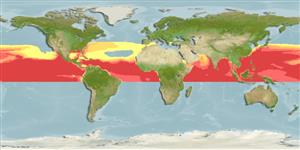Environment: milieu / climate zone / depth range / distribution range
Οικολογία
Θαλασσινό(ά); ωκεανόδρομο(ς) (Ref. 51243); εύρος βάθους 0 - ? m. Tropical; 42°N - 36°S, 180°W - 180°E (Ref. 93339)
Circumglobal: all oceans preferably open ocean waters.
Atlantic: northward from 37°N in the western part of the ocean to 25° N in the eastern part and southward from 30° S in the western part to 8° S in the eastern part; somewhat broader in the Eastern Atlantic. It is quite rare in the Caribbean (except for the eastern part) and in the Gulf of Mexico.
Indian Ocean: Arabian Sea and Bay of Bengal in the north to the southern end of Africa and the western coast of Australia in the south; not found in the Red Sea, Aden, Oman and the Persian Gulfs, as well as in the easternmost part of the Indian Ocean in the waters between the southern Indonesian islands and the northern coast of Australia. Juveniles are distributed throughout the range of the species except in the most southwestern areas from the Mozambique Channel to the False Bay and in the waters off the west coast of Australia; juveniles were found in all seasons.
Pacific Ocean: northward from the northwestern tip of the Honshu Island in the west to 20° N in the east, and southward from the east coast of Australia to the waters of Ecuador and
Peru. Absent in the East China, Yellow and Japan Seas, quite rare in the South China Sea, none in the inner Indonesian seas.
Μέγεθος / Βάρος / Age
Maturity: Lm ? range ? - ? cm
Max length : 25.1 cm SL αρσενικό/απροσδιόριστο; (Ref. 93339)
Ραχιαίες άκανθες (συνολικά): 0; Μαλακές ραχιαίες ακτίνες (συνολικά): 10-12; Εδρικές άκανθες 0; Μαλακές εδρικές ακτίνες: 11 - 13. Body dark, iridescent blue above, silvery white below; dorsal and caudal fins greyish, other fins hyaline (Ref. 2797). Juveniles elongate, paired fins mottled (Ref. 2797).
Found in oceanic surface waters (Ref. 9839). Caught in surface waters over the depths 80-10,400 meters, usually 2000 to 6000 m (mean 4423 m) (Ref. 93339). Spawns throughout the year in warm waters (Ref. 6523).
Life cycle and mating behavior
Γεννητική Ωρίμανση | Αναπαραγωγή | Γεννοβολία | Αβγά | Γονιμότητα | Προνύμφες
Shakhovskoy, I.B. and N.V. Parin, 2013. A review of flying fishes of the subgenus Hirundichthys (genus Hirundichthys, Exocoetidae). 1. Oceanic species: H. speculiger, H. indicus sp. nova. J. Ichthyol. 53(2):117-145. (Ref. 93339)
IUCN Red List Status (Ref. 130435)
Threat to humans
Harmless
Human uses
αλιεία: περιορισμένης εμπορικότητας
Περισσότερες πληροφορίες
Κοινά ονόματαΣυνώνυμαΜεταβολισμόςΘηρευτέςΟικοτοξικολογίαΑναπαραγωγήΓεννητική ΩρίμανσηΓεννοβολίαΣυναθροίσεις γεννοβολίαςΓονιμότηταΑβγάEgg development
ΑναφορέςΥδατοκαλλιέργειεςΠροφίλ υδατοκαλλιέργειαςΣτελέχοιΓενετικήElectrophoresesΚληρονομικότηταΑσθένειεςΜεταποίησηNutrientsMass conversion
ΣυνεργάτεςΦωτογραφίεςStamps, Coins Misc.ΉχοιΣιγκουατέραΤαχύτηταΚολυμβητικός ΤύποςΕπιφάνεια βραγχίωνOtolithsΕγκέφαλοιΌραση
Εργαλεία
Special reports
Download XML
Διαδικτυακές πηγές
Estimates based on models
Preferred temperature (Ref.
123201): 1.2 - 2.9, mean 1.5 °C (based on 26666 cells).
Phylogenetic diversity index (Ref.
82804): PD
50 = 0.5002 [Uniqueness, from 0.5 = low to 2.0 = high].
Bayesian length-weight: a=0.00646 (0.00292 - 0.01429), b=3.04 (2.84 - 3.24), in cm total length, based on LWR estimates for this (Sub)family-body shape (Ref.
93245).
Τροφικό Επίπεδο (Ref.
69278): 3.0 ±0.08 se; based on food items.
Ελαστικότητα (Ref.
120179): Υψηλό, ελάχιστος χρόνος για διπλασιασμό πληθυσμού < 15 μήνες (Preliminary K or Fecundity.).
Fishing Vulnerability (Ref.
59153): Low vulnerability (21 of 100).
